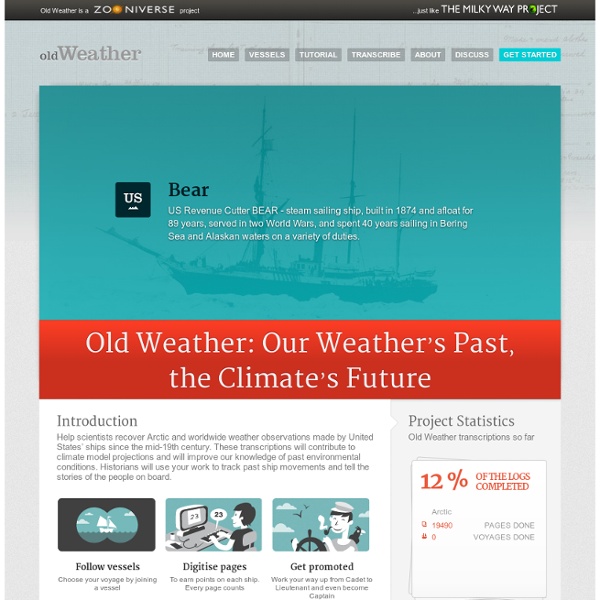



Citizen Science Alliance Predicting Weather United States Search and Rescue Task Force Predicting Weather What Is Weather? Weather simply refers to the condition of the air on earth at a given place and time - whether it is warm or cold, dry or wet, blowing or calm. Weather on earth starts with the sun. water evaporates into the air air rises As air rises, its temperature drops. Fronts and Air Masses Weather maps show the positions of air masses. When one air mass meets another, the air in different masses usually does not mix because the properties of the air are different. Cold Front A cold front forms where a cold air mass moves into a warm air mass. Warm Front A warm front forms where a warm air mass moves into a cold air mass. Stationary Front Even though air masses often move, sometimes they don't, resulting in a stationary front. High and Low Air Pressure Certain weather conditions are associated with high and low pressure systems. High Pressure Areas High pressure areas, or highs, are shown by "H" symbols. Low Pressure Areas Wind
Galaxy Zoo How to Predict the Weather Without a Forecast Steps Method 1 of 4: Observing the Sky 1Examine the clouds. The types of clouds in the sky, as well as the direction in which they're moving, can tell you a lot about upcoming weather. In general, clouds that are white and high indicate good weather, and clouds that are dark and low mean rain or storms are on the way. [1]The presence of cumulonimbus clouds early in the day, with more developing throughout the day can mean there's a greater chance of severe weather occurring soon.Mammatus clouds (formed by sinking air) can form with both severe and non-severe thunderstorms.Cirrus clouds, or "mare's tails," high in the sky like long streamers, mean bad weather is coming within the next 36 hours.Altocumulus clouds, which are like mackerel scales, also point to bad weather coming within the next 36 hours.Mackerel skies and mares tails formations sometimes appear in the same sky. 4Gaze at the moon. Method 2 of 4: Feeling the Wind and Air 1Detect the direction of the wind. 6Check for humidity.
Icelanders approve their crowdsourced constitution — European technology news AccuWeather Select interests to add to your dock Health Cold & FluAllergiesRespiratoryArthritisMigraineSinus TravelAstronomyEvents A.M. DrivingSchool DayHair DaySnow Days Home & Garden D.I.Y.Lawn & GardenHome EnergyEntertaining Sports & Recreation GolfSkiHuntingFishingRunningHikingBikingSun & SandSailing Crowdsourcing Crowdsourcing is a sourcing model in which individuals or organizations obtain goods and services. These services include ideas and finances, from a large, relatively open and often rapidly-evolving group of internet users; it divides work between participants to achieve a cumulative result. The word crowdsourcing itself is a portmanteau of crowd and outsourcing, and was coined in 2005.[1][2][3][4] As a mode of sourcing, crowdsourcing existed prior to the digital age (i.e. "offline").[5] There are major differences between crowdsourcing and outsourcing. Some forms of crowdsourcing, such as in "idea competitions" or "innovation contests" provide ways for organizations to learn beyond the "base of minds" provided by their employees (e.g. Definitions[edit] The term "crowdsourcing" was coined in 2005 by Jeff Howe and Mark Robinson, editors at Wired, to describe how businesses were using the Internet to "outsource work to the crowd",[1] which quickly led to the portmanteau "crowdsourcing."
NOAA news Microwork Microwork is a series of small tasks which together comprise a large unified project, and are completed by many people over the Internet. [1] [2] Microwork is considered the smallest unit of work in a virtual assembly line. [3] It is most often used to describe tasks for which no efficient algorithm has been devised, and require human intelligence to complete reliably. The term was developed in 2008 by Leila Chirayath Janah of Samasource. [4] [5] Microtasking[edit] Microtasking is the process of splitting a job into its component microwork and distributing this work over the Internet. Good candidates for microtasks have the following characteristics: they are large volume tasks, they can be broken down into tasks that are done independently, and they require human judgement.[6] Microtasks are distinguished from macrotasks which typically can be done independently, they require a fixed amount of time and they require a specialized skill. Services[edit] Uses[edit] Advantages[edit]